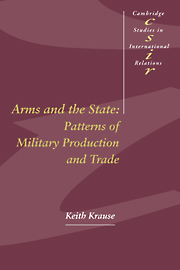Book contents
- Frontmatter
- Contents
- List of figures
- List of tables
- Acknowledgements
- Introduction
- 1 Motive forces in the evolution of the arms transfer and production system
- 2 The emergence of a global arms transfer and production system
- 3 From the Military Revolution to the Industrial Revolution
- 4 An overview of the post-1945 global arms transfer system
- 5 The dominance of first-tier producers and suppliers
- 6 Second-tier producers and suppliers: the struggle to keep pace
- 7 Dependent production and exports in the third tier
- 8 The subordinate role of arms recipients
- Conclusion
- Appendix: Arms transfer data sources and problems
- Notes
- Bibliography
- Index
Introduction
Published online by Cambridge University Press: 22 September 2009
- Frontmatter
- Contents
- List of figures
- List of tables
- Acknowledgements
- Introduction
- 1 Motive forces in the evolution of the arms transfer and production system
- 2 The emergence of a global arms transfer and production system
- 3 From the Military Revolution to the Industrial Revolution
- 4 An overview of the post-1945 global arms transfer system
- 5 The dominance of first-tier producers and suppliers
- 6 Second-tier producers and suppliers: the struggle to keep pace
- 7 Dependent production and exports in the third tier
- 8 The subordinate role of arms recipients
- Conclusion
- Appendix: Arms transfer data sources and problems
- Notes
- Bibliography
- Index
Summary
The arms trade is a ubiquitous aspect of international relations. Today it involves up to 50 states as suppliers and 120 as recipients, and its annual volume exceeds $48,000 million. But although its current scope and magnitude are unprecedented, arms transfers have been used at least since the Peloponnesian Wars to achieve the political, military and economic goals of states and rulers. The invention of the cannon in the fourteenth century, and the ‘Military Revolution’ of which it was a catalyst, ushered in the modern global arms transfer and production system, as leading suppliers of that time such as Liège and Venice shipped their products to customers across Europe. But over the following six centuries, suppliers ascended and disappeared and the trade, then as now, had an impact on the direction of international politics and the evolution of the modern state system.
The patterns of change and continuity in the modern state system are complex, multi-dimensional and ill understood. On the broad canvas, different writers have highlighted crucial turning points in the legal, economic, technological, military and political spheres. These include the crystallisation of the modern state system after the Peace of Westphalia, the emergence of market economics, the transition from mercantilism to capitalism, the technological transformation of the Industrial Revolution, the rise of modern nation-states, the changing nature of warfare and the rise and fall of empires.
- Type
- Chapter
- Information
- Arms and the StatePatterns of Military Production and Trade, pp. 1 - 11Publisher: Cambridge University PressPrint publication year: 1992
- 2
- Cited by

